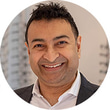- OT
- Life in practice
- Practitioner stories
- JJV’s contact lens recycling scheme
I could not live without…
JJV’s contact lens recycling scheme
Bhavin Shah explains why children are the most reliable users of his practice’s contact lens recycling scheme


Bhavin Shah
04 August 2022
The contact lens recycling scheme that we use is the one facilitated by Johnson & Johnson Vision (JJV). We started using it pre-pandemic, in February 2019. Before we set up the scheme in the practice, JJV had either sent an email, or I saw the scheme mentioned in Optometry Today . I contacted them, and they put me into their partnership programme. The setup process itself was very easy.
Whenever we fill the box, we just email TerraCycle, JJV’s partner in the programme. On the website, there’s a form that you fill out, and they email through a UPS label and arrange for them to come and pick it up. Because we collect a high volume of lenses from patients, they’ve arranged for one box for free for us, despite them not providing boxes for free anymore. We fill up a box at least once every two months, maybe more often.
The feelgood factor
The patients have loved it. Something like 80% of our daily soft lens wearers are children, and they’re really into environmental, social and corporate governance, and sustainability. I think it’s one of the things that has been promoted a lot in schools, so they’re very aware of the issue of sustainability and the plastic pollution problem. They are quite good at being organised and saving their lenses and bringing them in when they come for appointments. It’s their future. We’re protecting the planet for them, and I think they’re aware of that.In terms of getting the message out to patients about the fact they could recycle their contact lenses in the practice, we initially sent out an email. We see our contact lens wearers quite frequently, at least every six months, so we also speak to them about the scheme when we see them. We remind them every time.
We’re protecting the planet for them, and I think they’re aware of that
During the consultation, they’ll have to take their lenses out at some point, and I’ve got a little recycling bin, like a miniature wheelie bin, in my consulting room. I tell them to put the lenses in there, and then I add it to the bigger bin later. Parents, even though they’ve been told before, will sometimes say, “Oh, I didn’t know you did that.” Hopefully the message will start to stick with them.
I think it is a question of just reminding people all the time. Adults forget; the kids have better intentions. I think they’re a bit more committed to saving them. I had one child who had three different containers, and he’d separated the plastic part, the foils, and the lenses. Children feel like it gives them a sense of responsibility, I think.
You have to make it really easy for an adult. If they’re collecting their lenses at home, if they’ve got a box to drop them in right there, it gets done. If it’s not there, then in that extra time it gets forgotten.
I think patients do realise that, with contact lenses, they are generating lots of plastic waste. Although actually, the plastic waste generated by dailies is less than it is by monthlies, because of the use of the solutions. Some of the solution bottles can’t be recycled. Patients know, when they are generating this waste, that they can be doing something about it. I think it helps raise people’s awareness, too. It’s an easy feelgood factor for people.
A sustainability ecosystem
We’re trying to be environmentally conscious where we can, and look at areas where we can make an impact. The JJV contact lens recycling scheme is one of the key things that we’re doing in practice in terms of sustainability. We’ve also gone paperless over the last few years. We changed all our light bulbs to LED about four years ago, and it brought down our electricity bill by at least 50%, maybe more. We’ve also got a couple of frame ranges that are eco-friendly. Patients are looking for that, as well. With all of those things combined, it feels like we’re doing something, at least.
Advertisement

Comments (0)
You must be logged in to join the discussion. Log in